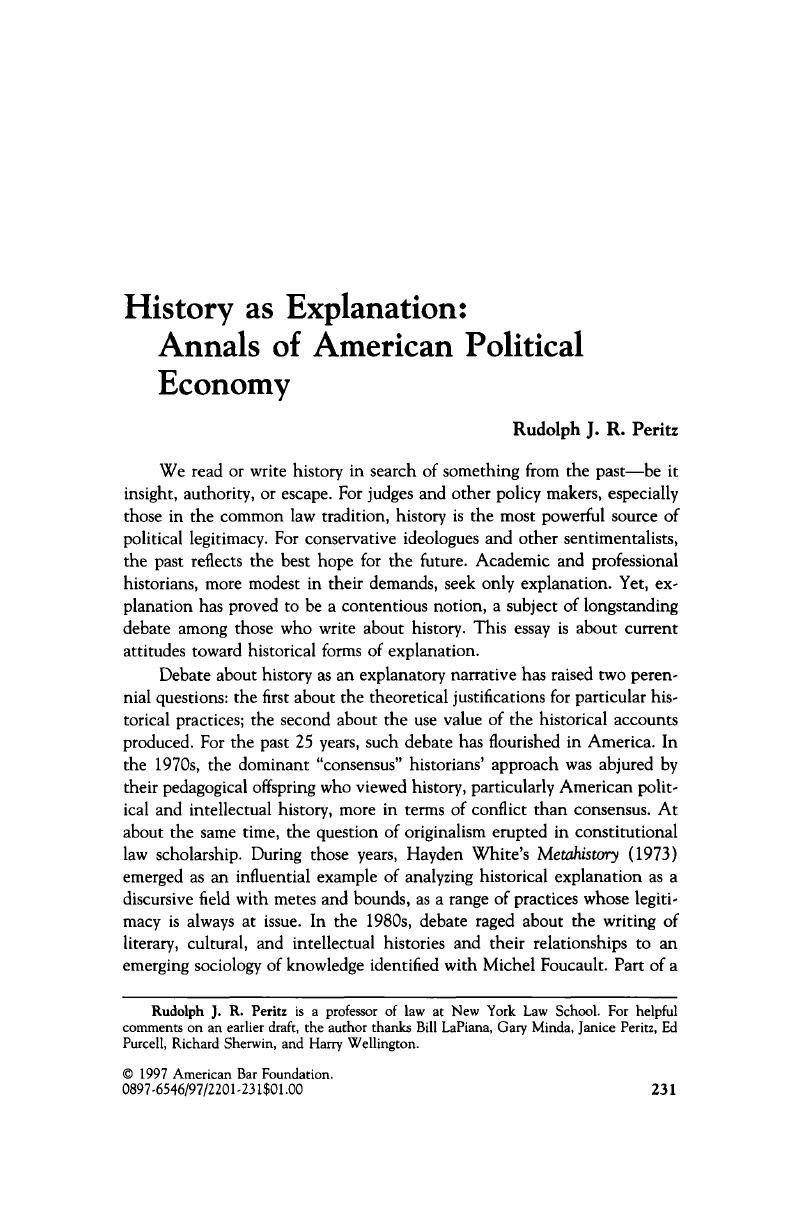No CrossRef data available.
Article contents
History as Explanation: Annals of American Political Economy
Published online by Cambridge University Press: 27 December 2018
Abstract
An abstract is not available for this content so a preview has been provided. Please use the Get access link above for information on how to access this content.

- Type
- Review Essay
- Information
- Copyright
- Copyright © American Bar Foundation, 1997
References
Appleby, Joyce, Hunt, Lynn, and Jacob, Margaret. 1994. Telling the Truth about History. New York: W. W. Norton.Google Scholar
Arthur, W. Brian. 1989. Competing Technologies, Increasing Returns, and Lock-in by Historical Events. Economics Journal
99, 116–31.Google Scholar
Burke, Kenneth. 1984 [1937]. Attitudes toward History. Berkeley: University of California Press.Google Scholar
Carlyle, Thomas. 1969 [I860]. “On History.” In A Carlyk Reader, edited by Tennyson, G. B.
New York: Modern Library.Google Scholar
Chamberlin, Edward H.
1932. The Theory of Monopolistic Competition. Cambridge: Harvard University Press.Google Scholar
Chandler, Alfred D.
1977. The Visible Hand: The Managerial Revolution in American Business. Cambridge: Harvard University Press.Google Scholar
Chandler, Alfred D.
1990. Scale and Scope: The Dynamics of Industrial Capitalism. Cambridge-Harvard University Press.Google Scholar
Davis, Lance E., and North, Douglass C.
1971. Institutional Change and American Economic Growth. Cambridge: Cambridge University Press.Google Scholar
Derrida, Jacques. 1970. Structure, Sign, and Play in the Discourse of the Human Sciences. In The Structuralist Controversy, edited by Macksey, Richard and Donate, Eugenio Baltimore: Johns Hopkins University Press.Google Scholar
Derrida, Jacques. 1976 [1967]. Of Grammatology, translated by Spivak, Gayatri C.
Baltimore: Johns Hopkins University Press.Google Scholar
DuBoff, Richard B.
1989. Accumulation and Power: An Economic History of the United States. Armonk, N.Y.: M. E. Sharpe.Google Scholar
Ernst, Daniel R.
1993. Review Essay: The Critical Tradition in the Writing of American Legal History. Yale Law Journal
102, 1019–76.Google Scholar
Fligstein, Neil. 1990. The Transformation of Corporate America. Cambridge: Harvard University Press.Google Scholar
Foucault, Michel. 1977. Language, Counter-Memory, Practice. Ithaca, N.Y.: Cornell University Press.Google Scholar
Freyer, Tony. 1992. Regulating Big Business: Antitrust in Great Britain and America, 1880–1990. New York: Cambridge University Press.Google Scholar
Friedman, Lawrence M.
1968. Heart against Head: Perry Miller and the Legal Mind. Yale Law joumal
77, 1244–63.Google Scholar
Glick, Mark, and Ehrbar, Hans. 1990. Long-Run Equilibrium in the Empirical Study of Monopoly and Equilibrium. Economic Inquiry
28, 151–62.Google Scholar
Goldin, Claudia, and Libecap, Gary, eds. 1994. The Regulated Economy: A Historical Approach to Political Economy. Chicago: University of Chicago Press.Google Scholar
Gordon, Robert W.
1981. “Historicism in Legal Scholarship. Yale Law Journal
90, 1017–56.Google Scholar
Gordon, Robert W.
1994. The Elusive Transformation. Yale Journal of Law and Humanities
6, 137–62.Google Scholar
Habermas, Jiirgen. 1979 [1976]. Communication and the Evolution of Society, translated by McCarthy, Thomas. Boston: Beacon Press.Google Scholar
Hartz, Louis. 1948. Economic Policy and Democratic Thought. Cambridge: Harvard University Press.Google Scholar
Horwitz, Morton J.
1977. The Transformation of American Law, 1780–1860. Cambridge: Harvard University Press.Google Scholar
Horwitz, Morton J.
1992. The Transformation of American Law, 1870–1960. New York: Oxford University Press.Google Scholar
Hovenkamp, Herbert. 1991. Enterprise and American Law, 1836–1937. Cambridge: Harvard University Press.Google Scholar
Hurst, James Willard. 1956. Law and the Conditions of Freedom in the Nineteenth-Century United States. Madison: University of Wisconsin Press.Google Scholar
Jameson, Fredric. 1991. Postmodernism: The Cultural Logic of Late Capitalism. Durham, N.C.: Duke University Press.Google Scholar
Keller, Morton. 1990. Regulating a New Economy: Public Policy and Economic Change in America, 1900–1933. Cambridge: Harvard University Press.Google Scholar
Kloppenberg, James T.
1993. Book Review: The Theory and Practice of American Legal History. Harvard Law Review
106, 1332–51.Google Scholar
Kuhn, Thomas. 1970. The Structure of Scientific Revolutions. 2d ed. Chicago: University of Chicago Press.Google Scholar
Leff, Arthur. 1974. Economic Analysis of Law: Some Realism about Nominalism. Virginia Law Review
60, 451–83.Google Scholar
LeVi-Strauss, Claude. 1969 [1949]. The Elementary Structures of Kinship. Boston: Beacon Press.Google Scholar
Lindblom, Charles. 1977. Politics and Markets: The World's Pohacal-Economic Systems. New York: Basic Books.Google Scholar
Lyotard, Jean-Francois.
1984 [1979]. The Postmodern Condition: A Report on Knowledge, translated by Bennington, Geoff and Massumi, Brian. Minneapolis: University of Minnesota Press.Google Scholar
Mercer, Helen. 1995. Constructing a Competitive Order: The Hidden History of British Antitrust Policies. New York: Cambridge University Press.Google Scholar
Moglen, Eben. 1993. Book Review: The Transformation of Morton Horwitz. Columbia Law Review
93, 1042–59.Google Scholar
Nietzsche, Friedrich.
1981 [1873]. The Use and Abuse of History, translated by Collins, A.
Indianapolis: Bobbs-Merrill Educational Publishing.Google Scholar
Pepper, Stephen C.
1961 [1942]. World Hypotheses: A Study in Evidence. Berkeley: University of California Press.Google Scholar
Peritz, Rudolph J. R.
1989. A Genealogy of Vertical Restraints Doctrine. Hastings Law Journal
40, 511–76.Google Scholar
Peritz, Rudolph J. R.
1996. Competition Policy in America, 1888–1992: History, Rhetoric, Law. New Yotk: Oxford University Press.Google Scholar
Purcell, Edward A. Jr.
1992. Litigation and Inequality: Federal Diversity Jurisdiction in Industrial America, 1870–1958. New York: Oxford University Press.Google Scholar
Ravenscraft, David J.
1985. Structure-Profit Relationships at the Line of Business and Industry Level. Review of Economics and Statistics
65, 22–31.Google Scholar
Roe, Mark J.
1994. Strong Managers, Weak Owners: The Political Roots of American Corporate Finance. Princeton, N.J.: Princeton University Press.Google Scholar
Sklar, Martin J.
1988. The Corporate Reconstruction of American Capitalism, 1890–1916: The Market, the Law, and Politics. New York: Cambridge University Press.Google Scholar
Tushnet, Matk. 1990. Introduction to Symposium: On the Frontiet of Legal Thought. Duke L. Rev.
1990, 375–430.Google Scholar
White, G. Edward. 1993. Transforming History in the Postmodern Era. Michigan Law Review
91, 1315–52.Google Scholar
Edward, G.
1994. Intervention and Detachment: Essays in Legal History and Jurisprudence. New York: Oxford University Press.Google Scholar
White, Hayden. 1973. Metohistory: The Historical Imagination in Nineteenth-Century Europe. Baltimore: Johns Hopkins University Press.Google Scholar




